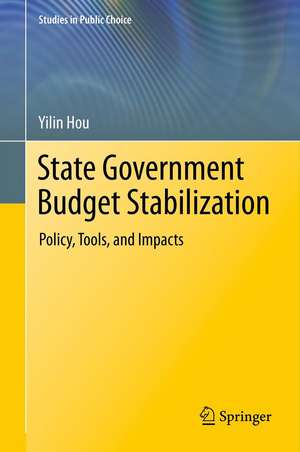State Government Budget Stabilization: Policy, Tools, and Impacts: Studies in Public Choice, cartea 8
Autor Yilin Houen Limba Engleză Hardback – 31 ian 2013
With the lingering effects of the most recent financial crisis and economic downturn, and the subsequent Tea Party movement advocating smaller government and deficit reduction, this book carries timely and important theoretical as well as practical implications, particularly in regard to the potential for counter-cyclical fiscal policy in mitigating negative impacts during a recession. The first contribution of the book is in public finance theory: it provides insights into the applications of the stabilization function in the context of strong government, thereby refining Keynesianism. The second aspect is in Public Choice: the creation and functioning of budget stabilization funds offer extra evidence to demonstrate that the general public provides input and voice in more than the conventional ways when it comes to policy making, even in an area dominated by strong government. The third aspect is in policy making, exploring the opportunities for refining policy tools in preparation for future downturns.
| Toate formatele și edițiile | Preț | Express |
|---|---|---|
| Paperback (1) | 644.30 lei 6-8 săpt. | |
| Springer – 8 feb 2015 | 644.30 lei 6-8 săpt. | |
| Hardback (1) | 579.90 lei 17-23 zile | +50.97 lei 10-14 zile |
| Springer – 31 ian 2013 | 579.90 lei 17-23 zile | +50.97 lei 10-14 zile |
Din seria Studies in Public Choice
-
 Preț: 542.83 lei
Preț: 542.83 lei - 18%
 Preț: 958.38 lei
Preț: 958.38 lei - 18%
 Preț: 780.82 lei
Preț: 780.82 lei -
 Preț: 395.09 lei
Preț: 395.09 lei - 5%
 Preț: 370.58 lei
Preț: 370.58 lei -
 Preț: 381.81 lei
Preț: 381.81 lei - 18%
 Preț: 1228.77 lei
Preț: 1228.77 lei - 15%
 Preț: 637.46 lei
Preț: 637.46 lei - 18%
 Preț: 942.63 lei
Preț: 942.63 lei - 15%
 Preț: 640.71 lei
Preț: 640.71 lei - 15%
 Preț: 633.53 lei
Preț: 633.53 lei - 18%
 Preț: 945.62 lei
Preț: 945.62 lei - 20%
 Preț: 560.55 lei
Preț: 560.55 lei - 18%
 Preț: 947.50 lei
Preț: 947.50 lei - 15%
 Preț: 632.37 lei
Preț: 632.37 lei - 15%
 Preț: 635.15 lei
Preț: 635.15 lei - 15%
 Preț: 634.49 lei
Preț: 634.49 lei - 15%
 Preț: 635.01 lei
Preț: 635.01 lei - 15%
 Preț: 638.89 lei
Preț: 638.89 lei -
 Preț: 381.81 lei
Preț: 381.81 lei - 15%
 Preț: 640.88 lei
Preț: 640.88 lei -
 Preț: 385.62 lei
Preț: 385.62 lei -
 Preț: 393.13 lei
Preț: 393.13 lei - 15%
 Preț: 697.00 lei
Preț: 697.00 lei - 15%
 Preț: 586.70 lei
Preț: 586.70 lei -
 Preț: 389.31 lei
Preț: 389.31 lei - 15%
 Preț: 643.84 lei
Preț: 643.84 lei - 18%
 Preț: 727.00 lei
Preț: 727.00 lei
Preț: 579.90 lei
Preț vechi: 724.88 lei
-20% Nou
Puncte Express: 870
Preț estimativ în valută:
110.96€ • 116.17$ • 91.82£
110.96€ • 116.17$ • 91.82£
Carte disponibilă
Livrare economică 11-17 martie
Livrare express 04-08 martie pentru 60.96 lei
Preluare comenzi: 021 569.72.76
Specificații
ISBN-13: 9781461460602
ISBN-10: 1461460603
Pagini: 376
Ilustrații: XX, 356 p.
Dimensiuni: 155 x 235 x 26 mm
Greutate: 0.73 kg
Ediția:2013
Editura: Springer
Colecția Springer
Seria Studies in Public Choice
Locul publicării:New York, NY, United States
ISBN-10: 1461460603
Pagini: 376
Ilustrații: XX, 356 p.
Dimensiuni: 155 x 235 x 26 mm
Greutate: 0.73 kg
Ediția:2013
Editura: Springer
Colecția Springer
Seria Studies in Public Choice
Locul publicării:New York, NY, United States
Public țintă
ResearchCuprins
Table of Contents.- Preface.- List of Abbreviations.- 1. Introduction and Overview.- Part I: From Economic Stabilization to Budget Stabilization: Theory and Tools.- 2. From Economic Stabilization to Budget Stabilization.- 3. Subnational Government Tools for Budget Stabilization.- Part II: Boom-Year Savings and Effects in Bust Years.- 4. Patterns of State Savings with BSF and GFS.- 5. State Saving Behavior – Effects of BSF in Interaction with BBR.- 6. Effects of Boom-year Savings across Three Types of State Expenditures.- 7. Effects of Boom-year Savings on Bust-year Budgetary Actions.- Part III: Implications for Budgeting and Financial Management.- 8. Budgeting for Fiscal Stability over the Economic Cycle.- 9. Boom-Year Savings and Budgetary Forecasting.- 10. Debt as Counter-cyclical Fiscal Tool.- 11. A Framework for Fiscal Policy Coordination and Economic Stability.- 12. Prospects for Budget Stabilization by Subnational Governments.- References.- Notes.- General Appendixes.- Index.
Textul de pe ultima copertă
This book is the first comprehensive, full-scale treatment of the law, politics and economics with regard to the policies and policy instruments for budget stabilization at the state level. Covering the period from 1946 through 2008 in the United States, it provides details on the methods and results of empirical tests of the effects of budget stabilization instruments on government operations, public service provision, and some other aspects of social and economic life.
With the lingering effects of the most recent financial crisis and economic downturn, and the subsequent Tea Party movement advocating smaller government and deficit reduction, this book carries timely and important theoretical as well as practical implications, particularly in regard to the potential for counter-cyclical fiscal policy in mitigating negative impacts during a recession. The first contribution of the book is in public finance theory: it provides insights into the applications of the stabilization function in the context of strong government, thereby refining Keynesianism. The second aspect is in Public Choice: the creation and functioning of budget stabilization funds offer extra evidence to demonstrate that the general public provides input and voice in more than the conventional ways when it comes to policy making, even in an area dominated by strong government. The third aspect is in policy making, exploring the opportunities for refining policy tools in preparation for future downturns.
With the lingering effects of the most recent financial crisis and economic downturn, and the subsequent Tea Party movement advocating smaller government and deficit reduction, this book carries timely and important theoretical as well as practical implications, particularly in regard to the potential for counter-cyclical fiscal policy in mitigating negative impacts during a recession. The first contribution of the book is in public finance theory: it provides insights into the applications of the stabilization function in the context of strong government, thereby refining Keynesianism. The second aspect is in Public Choice: the creation and functioning of budget stabilization funds offer extra evidence to demonstrate that the general public provides input and voice in more than the conventional ways when it comes to policy making, even in an area dominated by strong government. The third aspect is in policy making, exploring the opportunities for refining policy tools in preparation for future downturns.
Caracteristici
Applies a Public Choice approach to a timely issue of public administration Draws from a century of data, and includes in-depth analysis of budget stabilization initiatives in several States Considers practical and policymaking implications Includes supplementary material: sn.pub/extras
















